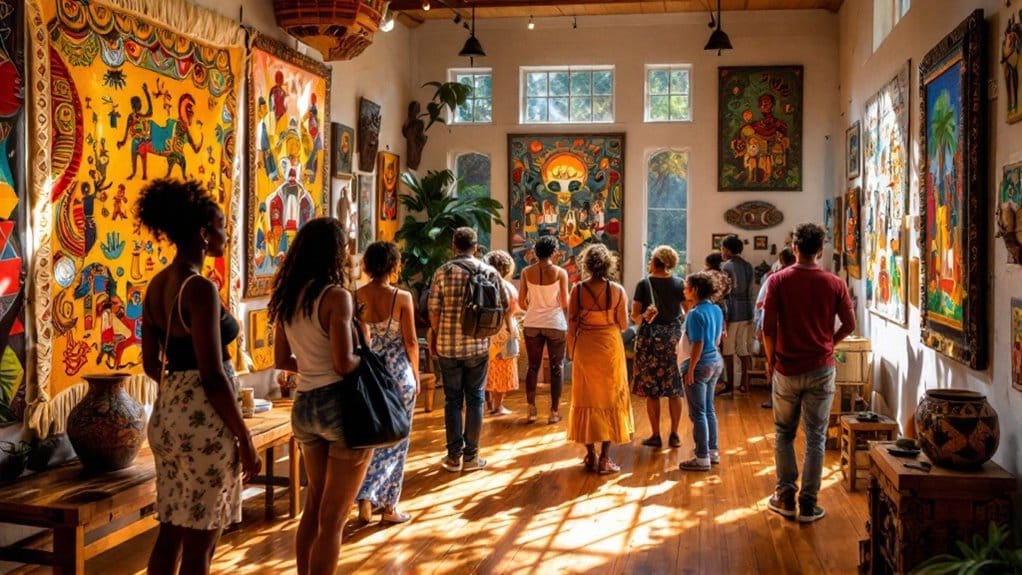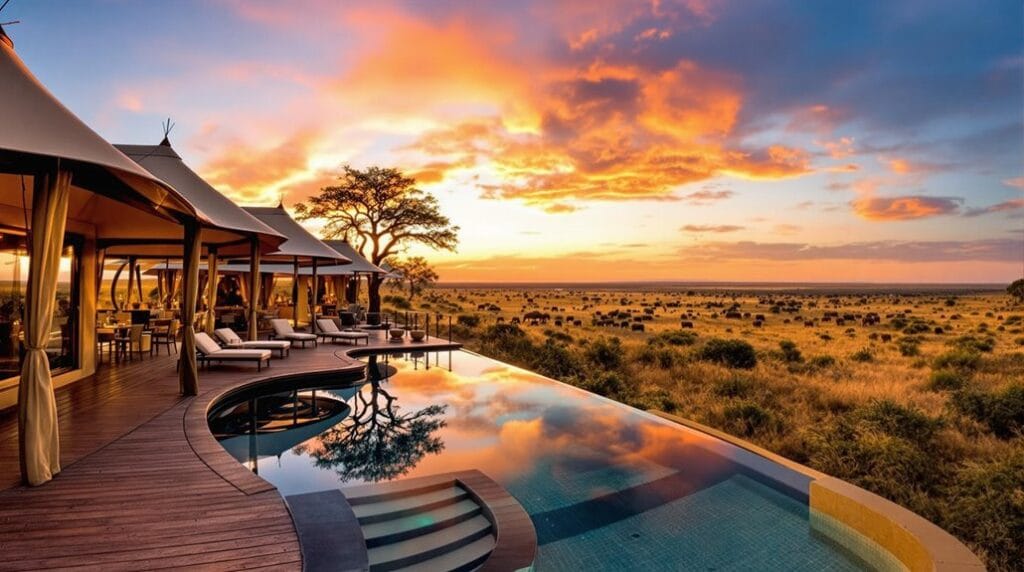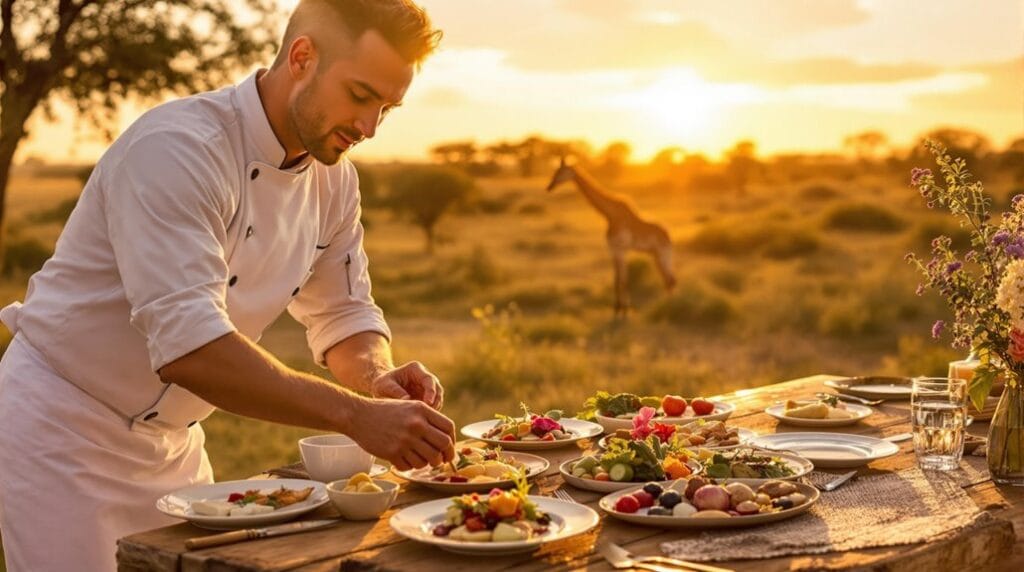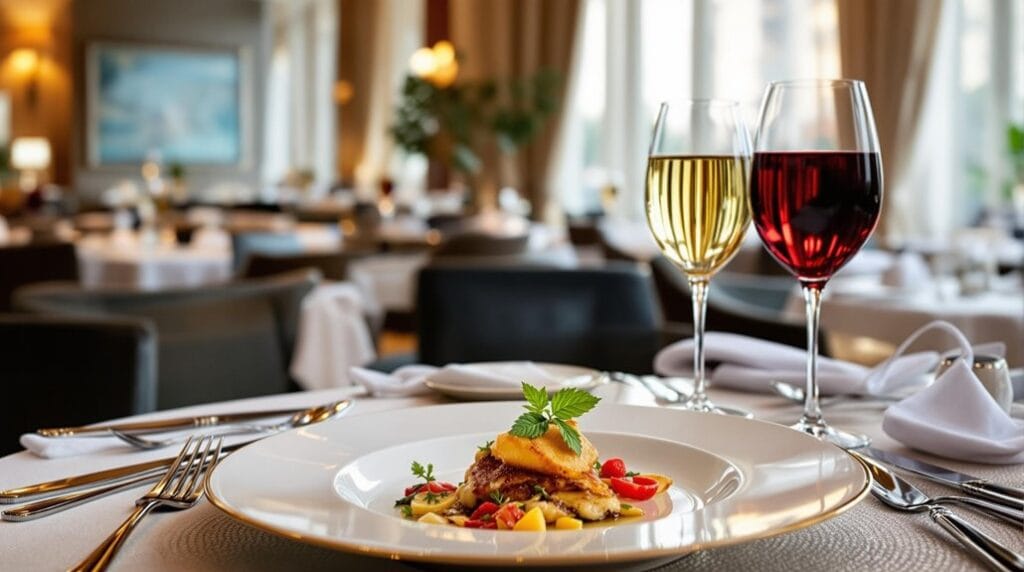If you're looking to explore Indigenous art in Africa's cities, check out highlights like the African Heritage House in Nairobi and the Mali Museum in Bamako. The Iziko South African Museum connects indigenous art with archaeology, while the Tingatinga Arts Cooperative in Dar es Salaam showcases vibrant wildlife paintings. You'll also find unique experiences at the Nairobi Gallery, highlighting pan-African art. In major hubs like Dakar and Johannesburg, galleries are revitalizing spaces and promoting community engagement. Each venue narrates stories of cultural identity and heritage. There's so much more to learn about these incredible spaces and their impact.
Key Takeaways
- The African Heritage House in Nairobi showcases traditional and contemporary African art, emphasizing cultural heritage and community outreach.
- The Mali Museum in Bamako focuses on preserving Mali's rich artistic history and promoting local artists.
- Iziko South African Museum links indigenous art with archaeological exhibits, highlighting South Africa's diverse cultural tapestry.
- The National Museum of African Art in Washington, D.C. emphasizes repatriation and cultural exchange, connecting African art with global audiences.
- Afriart Gallery in Kampala promotes contemporary African art, fostering dialogue and cultural exchange among local and international artists.
Overview of Indigenous Art Galleries
Showcasing the rich tapestry of Africa's cultural heritage, indigenous art galleries play an essential role in preserving and presenting both traditional and contemporary artworks.
These galleries, like the African Heritage House in Nairobi and the Mali Museum in Bamako, offer you a window into the diverse artistic practices of various ethnic groups. They highlight the beauty and complexity of traditional art forms while also embracing contemporary artworks that resonate with modern audiences.
Visiting an indigenous art gallery can deepen your appreciation for Africa's cultural heritage. The Iziko South African Museum, for instance, features indigenous artworks alongside archaeological exhibits, linking the past to the present.
Many galleries prioritize community outreach and educational programs, ensuring that you and your community understand the significance of these artistic expressions.
At the National Museum of African Art in Washington, D.C., you can witness efforts toward the repatriation and display of African indigenous art, fostering cultural exchange and raising awareness.
Significance of Cultural Identity
Cultural identity in Africa thrives through the vibrant expressions found in indigenous art.
When you explore local galleries, you'll see how these artworks preserve heritage and narrate unique stories that define communities.
This connection between art and identity not only fosters pride but also highlights the importance of maintaining these cultural practices for future generations.
Preserving Heritage Through Art
Indigenous art galleries in Africa serve as essential spaces where heritage is preserved and celebrated, allowing you to connect with the unique identities and histories of various ethnic groups. These galleries showcase traditional crafts and artworks that reflect the continent's rich cultural heritage. Given that about 90% of Africa's art resides outside the continent, these galleries play a critical role in reclaiming local artistic expressions.
Through exhibitions and educational programs, indigenous art galleries foster a deeper understanding of cultural identity. They provide platforms for both contemporary artists and traditional craftsmen, ensuring that African artistic traditions thrive. Notable institutions like the Zinsou Foundation Museum and the Museum of Contemporary African Art Al Maaden highlight the significance of these artistic expressions.
| Gallery Name | Location | Focus Area |
|---|---|---|
| Zinsou Foundation Museum | Cotonou, Benin | Contemporary and traditional art |
| Museum of Contemporary African Art | Marrakech, Morocco | Modern African artistry |
| National Museum of African Art | Washington, D.C., USA | African artifacts and culture |
| The Cape Town Art Gallery | Cape Town, South Africa | South African artistic heritage |
| The African Heritage Centre | Durban, South Africa | Cultural education and crafts |
These spaces advocate for the restitution of cultural artifacts, reinforcing the importance of recognizing Africa's cultural narratives.
Art's Role in Identity
Art plays an essential role in shaping identity, allowing communities to express their histories, traditions, and values through various forms. By engaging with art, you connect with deeper layers of cultural identity that define who you are.
Contemporary artists like Franck Kemkeng Noah and Turiya Magadlela blend African culture with European influences, illustrating the complexities of identity in post-colonial contexts. Their works invite you to explore the rich tapestry of personal and collective histories.
Tapestries such as Tuli Mekondjo's "Omhepo yeni oili pokati ko miti" resonate with themes of displacement and connection, emphasizing how art articulates your shared experiences. In a world still grappling with colonial histories, the ongoing debates around the repatriation of cultural artifacts highlight art's power in reclaiming and reconstructing national identity.
Through these expressions, you find a sense of belonging and an opportunity to redefine societal relations. The stories told through art not only reflect your identity but also challenge you to understand and embrace the intricate narratives that shape your community.
In this way, art serves as a bridge, connecting past and present while celebrating the essence of who you are.
Emerging Art Scenes in Africa
As you explore the emerging art scenes in cities like Accra, Dakar, and Johannesburg, you'll notice a dynamic fusion of urban artistic innovations and cultural heritage celebrations.
Local artists aren't just creating; they're redefining their identities and histories through their work.
This vibrant atmosphere is transforming these cities into essential hubs for contemporary African art.
Urban Artistic Innovations
Across Africa, urban artistic innovations are thriving in cities like Accra, Lagos, and Nairobi, each carving out its own unique identity in the contemporary art landscape.
These emerging art scenes aren't just local phenomena; they're gaining international recognition. Events like the ART X Lagos art fair showcase over 30 galleries from more than 40 countries, providing a vibrant platform for African artists to connect with global audiences.
In Johannesburg, initiatives like the Joburg Contemporary Art Foundation are revitalizing old industrial spaces, turning them into dynamic venues for community engagement and creative expression.
Meanwhile, Nairobi has emerged as a vibrant hub for cultural exchange, with prominent galleries like Afriart Gallery supporting contemporary artists from across the continent.
The establishment of new museums, such as the Grand Egyptian Museum and the Edo Museum of West African Art, reflects a growing commitment to preserving and showcasing Africa's rich artistic heritage.
With these developments, you can see how the contemporary art scene in Africa is flourishing. It's an exciting time to be part of this artistic journey, where every brushstroke and installation tells a story of resilience, creativity, and community.
Cultural Heritage Celebrations
Cultural heritage celebrations in Africa are transforming the way communities engage with their artistic legacies. These events foster a sense of belonging and pride, uniting people through the rich tapestry of African heritage. Galleries and contemporary artists are at the forefront of this movement, showcasing the vibrant and diverse narratives that define the continent.
Here's a snapshot of key cultural heritage celebrations and their impact:
| Event | Location | Significance |
|---|---|---|
| Dakar Biennale | Dakar, Senegal | Connects artists, collectors, and the public, enhancing the city's artistic reputation. |
| Edo Museum of West African Art | Benin City, Nigeria | Celebrates and preserves indigenous art and heritage. |
| Afriart Gallery | Nairobi, Kenya | Emphasizes cultural exchange and showcases East Africa's artistic heritage. |
| Goodman Gallery | Johannesburg, South Africa | Promotes local talent and addresses social issues through contemporary photography. |
These emerging art scenes highlight the importance of cultural exchange, allowing you to connect with stories that resonate deeply. By engaging with these celebrations, you're not just witnessing art; you're becoming part of a living legacy that honors the past while inspiring the future.
Notable Indigenous Artists
The richness of African indigenous art is powerfully expressed through the works of notable artists who draw deeply from their cultural heritage. These artists utilize traditional techniques and materials, creating contemporary African art that resonates with themes of identity and history.
For instance, Ghanaian artist El Anatsui transforms recycled materials into stunning large-scale sculptures, while Nigerian artist Yinka Shonibare uses Dutch wax fabric to explore colonialism and identity.
In South Africa, William Kentridge stands out as a celebrated South African artist, known for his impactful animated films and charcoal drawings that tackle pressing social and political issues in post-apartheid society.
Meanwhile, Sudanese artist Ibrahim El-Salahi merges traditional Islamic art with modern themes, earning international recognition.
Additionally, Kenyan artist Wangechi Mutu captivates audiences with her mixed media collages that investigate the complexities of gender, race, and environmental challenges.
These notable indigenous artists not only showcase their unique perspectives but also invite you to reflect on shared histories and experiences, fostering a sense of belonging within the vibrant tapestry of African art.
Their works are essential treasures found in art museums across the continent.
Unique Gallery Experiences
Visiting art galleries in Africa offers a vibrant journey into the continent's rich cultural heritage. Each gallery presents a unique gallery experience, immersing you in the diverse expressions of African artists.
At the Nairobi Gallery, you can explore pan-African artworks within a historic Victorian building, seamlessly blending art and architecture. The Tingatinga Arts Cooperative in Tanzania draws you in with its cartoon-like wildlife paintings, showcasing local talent and their distinctive styles.
In Uganda, Afriart Gallery fosters cultural exchange through contemporary African art, hosting art fairs that connect local artists with international collectors. You'll feel a sense of belonging as you engage with their stories and creations.
The Rwanda African Art Museum, opened in 2022, highlights the critical roles of women in African culture, offering insights into gender and art through traditional Congolese pieces.
Don't miss the Diani Beach Art Gallery in Kenya, where over 70 contemporary artists display fresh talent, creating a coastal art experience that resonates with visitors.
These galleries not only celebrate arts and culture but also invite you to be part of a broader narrative, enriching your understanding of Africa's vibrant artistic landscape.
Promoting African Heritage and Craftsmanship
Many indigenous art galleries across Africa actively promote the continent's rich heritage and craftsmanship, showcasing the unique skills and traditions of local artisans.
By featuring vibrant works from artists like those at the Tingatinga Arts Cooperative in Tanzania, you'll see how traditional techniques breathe life into paintings that capture the essence of wildlife and daily life.
Galleries such as the Afriart Gallery in Uganda bridge the gap between the past and present, celebrating both contemporary artists and the deep-rooted craftsmanship of Ugandan culture.
This fosters a sense of community and dialogue, helping you feel connected to the cultural heritage of Africa.
In South Africa, Kalashnikovv Gallery nurtures emerging indigenous artists, giving them a platform to express their creativity while promoting sustainable practices.
The Zoma Museum in Ethiopia goes a step further by integrating traditional materials into modern artistic expressions, preserving essential cultural narratives.
Frequently Asked Questions
Which City Has the Best Art Galleries?
When you're exploring which city has the best art galleries, consider how they showcase local artists and their unique cultural significance.
Look for gallery exhibitions that highlight traditional techniques alongside contemporary styles.
Cities hosting vibrant art festivals often foster community engagement and artistic collaborations, enriching the local scene.
Whether in Johannesburg, Accra, Lagos, Nairobi, or Dakar, each offers something special, so immerse yourself in their art worlds and find where you feel most connected.
What Is the Art Capital of Africa?
When you think about the art capital of Africa, you can't overlook cities like Dakar and Johannesburg.
Each city showcases its unique artistic heritage, blending contemporary expressions with traditional techniques. Dakar's cultural significance shines through its vibrant artistic communities and the Dak'Art Biennale.
Similarly, Johannesburg's galleries highlight indigenous influences and visual storytelling.
Ultimately, the title might vary, but these cities undeniably reflect Africa's rich and diverse art scene.
What Is the Most Popular Art in Africa?
When you explore art in Africa, you'll find a vibrant mix of traditional crafts and contemporary artists.
Textile art and various sculpture styles reflect cultural significance, showcasing indigenous techniques passed down through generations.
Art movements in cities like Accra and Lagos highlight this blend, celebrating diversity.
Art festivals, such as Dak'Art, bring these works to life, allowing you to connect with the rich heritage and innovative spirit of African artistry.
What Are the Tribal Arts in Africa?
When you explore tribal arts in Africa, you'll discover a vibrant mix of wood carvings, pottery styles, and intricate beadwork techniques. Each piece tells a story, reflecting local storytelling traditions and cultural heritage.
You might find stunning tribal masks used in rituals, unique textile patterns, and even body painting that celebrates identity.
Ceremonial artifacts not only showcase craftsmanship but also connect you to the rich history and communal spirit of diverse African cultures.
Conclusion
In exploring Africa's vibrant indigenous art galleries, you'll uncover not just stunning works but also the rich cultural identities they represent. Did you know that over 70% of Africa's population is under 30? This youthful energy is fueling a dynamic art scene that celebrates heritage while embracing modernity. By supporting these galleries, you're not only experiencing unique artistry but also contributing to the preservation of cultural traditions for future generations. Immerse yourself and discover the stories waiting to be told!








